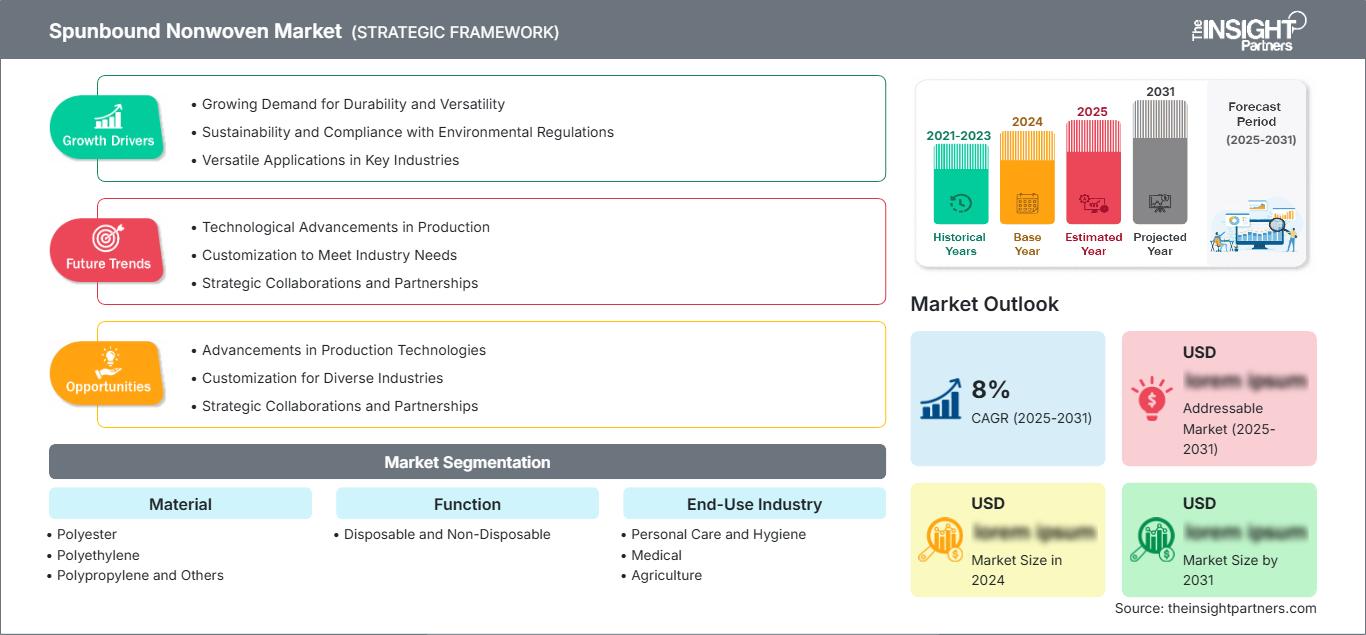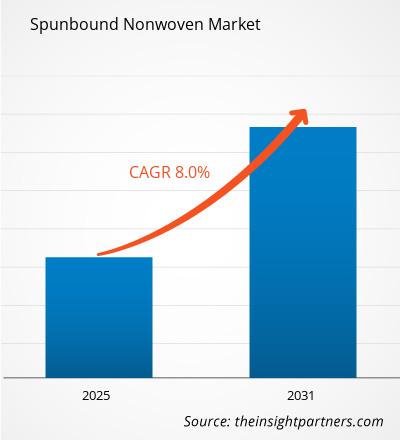Se espera que el mercado de telas no tejidas spunbound registre una CAGR del 8% entre 2025 y 2031, con un tamaño de mercado que se expandirá de US$ XX millones en 2024 a US$ XX millones en 2031.
El informe está segmentado por material (poliéster, polietileno, polipropileno y otros) y función (desechable y no desechable). Además, presenta un análisis basado en la industria de uso final (cuidado personal e higiene, medicina, agricultura, embalaje, automoción, etc.). El análisis global se desglosa a nivel regional y por países principales. El alcance del informe abarca el tamaño y las previsiones del mercado a nivel global, regional y nacional para todos los segmentos clave. El informe ofrece el valor en USD para el análisis y los segmentos mencionados. El informe proporciona estadísticas clave sobre el estado del mercado de los principales actores y presenta tendencias y oportunidades.
Propósito del Informe
El informe Spunbound Nonwoven Market de The Insight Partners busca describir el panorama actual y el crecimiento futuro, los principales factores impulsores, los desafíos y las oportunidades. Esto proporcionará información a diversas partes interesadas del negocio, como:
- Proveedores/fabricantes de tecnología: Para comprender la dinámica cambiante del mercado y conocer las oportunidades potenciales de crecimiento, lo que les permitirá tomar decisiones estratégicas informadas.
- Inversores: Realizar un análisis exhaustivo de tendencias respecto a la tasa de crecimiento del mercado, las proyecciones financieras del mercado y las oportunidades que existen en toda la cadena de valor.
- Órganos reguladores: Regular las políticas y las actividades policiales en el mercado con el objetivo de minimizar el abuso, preservar la confianza de los inversores y defender la integridad y estabilidad del mercado.
Segmentación del mercado de telas no tejidas hiladas
Material
- Poliéster
- Polietileno
- Polipropileno y otros
Función
- Desechables y no desechables
Industria de uso final
- Cuidado personal e higiene
- Médico
- Agricultura
- Embalaje
- Automotriz y otros
Geografía
- América del norte
- Europa
- Asia-Pacífico
- América del Sur y Central
- Oriente Medio y África
Obtendrá personalización en cualquier informe, sin cargo, incluidas partes de este informe o análisis a nivel de país, paquete de datos de Excel, así como también grandes ofertas y descuentos para empresas emergentes y universidades.
Mercado de telas no tejidas hiladas: Perspectivas estratégicas

-
Obtenga las principales tendencias clave del mercado de este informe.Esta muestra GRATUITA incluirá análisis de datos, desde tendencias del mercado hasta estimaciones y pronósticos.
Factores que impulsan el crecimiento del mercado de telas no tejidas hiladas
- Creciente demanda de durabilidad y versatilidad: Los no tejidos spunbond son la última tendencia en el mercado textil. Ofrecen durabilidad, versatilidad y diversas aplicaciones. Se utilizan comúnmente en industrias como la automotriz, la construcción, la filtración y el cuidado personal. Con la creciente demanda de soluciones de alto rendimiento y rentabilidad, el creciente interés en los no tejidos spunbond cobra sentido.
- Sostenibilidad y Cumplimiento de la Normativa Ambiental: La creciente demanda de telas no tejidas spunbond se debe principalmente a la transición hacia la sostenibilidad y el cumplimiento de normativas ambientales más estrictas. Normalmente, los materiales denominados "ecologistas" son los más populares para las telas no tejidas spunbond, ya que la mayoría se pueden reciclar o reutilizar. El consumo de productos sostenibles es cada vez más frecuente y, en ocasiones, un requisito para gobiernos y consumidores, lo que ha incrementado enormemente la demanda de la categoría de telas no tejidas spunbond.
- Aplicaciones versátiles en industrias clave: Otro factor que impulsa la demanda de telas no tejidas spunbond es la presencia de potentes aplicaciones en las industrias de la construcción, la automoción y el cuidado personal. La demanda de materiales versátiles, ligeros y duraderos, como las telas no tejidas spunbond, aumenta con el crecimiento de estas industrias. El crecimiento de la población mundial impulsa el desarrollo de infraestructuras y bienes de consumo, lo que incrementa la demanda de este mercado.
Tendencias futuras del mercado de telas no tejidas hiladas
- Avances tecnológicos en la producción: Los fabricantes de telas no tejidas hiladas se han esforzado a lo largo de los años por desarrollar mejores tecnologías de producción, lo que aumentaría la eficiencia y la calidad, y abarataría el precio de estas telas. Las líneas de producción de alta velocidad se combinan con técnicas de unión de fibras compartidas, impulsadas por la automatización y la robótica para optimizar todo el proceso de fabricación. Todos estos avances tecnológicos pueden contribuir a una producción más eficiente y a satisfacer la creciente demanda de telas no tejidas hiladas.
- Personalización para satisfacer las necesidades de la industria: La creciente tendencia de personalización se centra en los productos no tejidos hilados para satisfacer las diferentes necesidades de cada industria. Los fabricantes ofrecen una amplia gama de opciones en cuanto a la composición de la fibra, el gramaje del tejido o los acabados superficiales. Una organización puede diferenciar su producto de otras empresas mediante productos personalizados y obtener una ventaja competitiva en el mercado.
- Colaboraciones y alianzas estratégicas: El mercado de telas no tejidas spunbound es cada vez más testigo del surgimiento de colaboraciones y alianzas estratégicas entre fabricantes, proveedores de materias primas e industrias de consumo final. Estas alianzas tienen como objetivo específico optimizar el desarrollo del producto, optimizar la eficiencia de la cadena de suministro y permitir una mayor expansión en el mercado. Las organizaciones unen cada vez más fuerzas para acceder a conocimientos y recursos complementarios e innovar mejor para satisfacer las cambiantes necesidades del mercado.
Oportunidades de mercado de telas no tejidas hiladas
- Avances en las tecnologías de producción: El desarrollo de tecnologías de producción avanzadas se ha convertido en un esfuerzo constante para los fabricantes con el fin de mejorar la calidad, la eficiencia y la rentabilidad en la producción de no tejidos hilados. Las líneas de producción de alta velocidad, las mejoras en la unión de fibras y la integración de la automatización y la robótica han impulsado una mejora general en la fabricación. Estos avances permiten a los productores satisfacer la creciente demanda de no tejidos hilados.
- Personalización para Diversas Industrias: Una tendencia creciente en la fabricación de telas no tejidas hiladas es su adaptación a las diversas industrias de uso final. Los fabricantes ofrecen a sus clientes una gama cada vez mayor de opciones en cuanto a composición de fibras, gramaje de las telas y acabados superficiales. La diferenciación y la ventaja competitiva que ofrece la personalización de productos a las empresas son excepcionales.
- Colaboraciones y alianzas estratégicas: El mercado de spunbond no tejido continúa creciendo gracias a la colaboración y alianzas estratégicas entre fabricantes, proveedores de materias primas e industrias usuarias finales. Esto unirá a estos socios en un mercado común que busca la reducción de costos y la mejora del desarrollo de productos, así como la mejora de la eficiencia en la cadena de suministro y la ampliación de las perspectivas del mercado. Estos actores también impulsan la innovación para satisfacer mejor las necesidades cambiantes del mercado.
Perspectivas regionales del mercado de telas no tejidas hiladas
Los analistas de The Insight Partners han explicado detalladamente las tendencias regionales y los factores que influyen en el mercado de telas no tejidas hiladas durante el período de pronóstico. Esta sección también analiza los segmentos y la geografía del mercado de telas no tejidas hiladas en América del Norte, Europa, Asia Pacífico, Oriente Medio y África, y América del Sur y Central.
Alcance del informe de mercado de telas no tejidas hiladas
| Atributo del informe | Detalles |
|---|---|
| Tamaño del mercado en 2024 | US$ XX millones |
| Tamaño del mercado en 2031 | US$ XX millones |
| CAGR global (2025-2031) | 8% |
| Datos históricos | 2021-2023 |
| Período de pronóstico | 2025-2031 |
| Segmentos cubiertos |
Por material
|
| Regiones y países cubiertos |
América del norte
|
| Líderes del mercado y perfiles de empresas clave |
|
Densidad de actores del mercado de telas no tejidas hiladas: comprensión de su impacto en la dinámica empresarial
El mercado de telas no tejidas Spunbound está creciendo rápidamente, impulsado por la creciente demanda del usuario final debido a factores como la evolución de las preferencias del consumidor, los avances tecnológicos y un mayor conocimiento de los beneficios del producto. A medida que aumenta la demanda, las empresas amplían su oferta, innovan para satisfacer las necesidades del consumidor y aprovechan las tendencias emergentes, lo que impulsa aún más el crecimiento del mercado.

- Obtenga una descripción general de los principales actores clave del mercado de no tejidos hilados
Puntos clave de venta
- Cobertura integral: el informe cubre de manera integral el análisis de productos, servicios, tipos y usuarios finales del mercado de no tejidos spunbound, proporcionando un panorama holístico.
- Análisis de expertos: el informe se compila con base en el conocimiento profundo de expertos y analistas de la industria.
- Información actualizada: El informe asegura relevancia comercial debido a su cobertura de información reciente y tendencias de datos.
- Opciones de personalización: este informe se puede personalizar para satisfacer los requisitos específicos del cliente y adaptarse adecuadamente a las estrategias comerciales.
Por lo tanto, el informe de investigación sobre el mercado de telas no tejidas hiladas puede ayudar a comprender mejor el panorama de la industria y sus perspectivas de crecimiento. Si bien existen algunas preocupaciones válidas, las ventajas generales de este informe suelen superar las desventajas.
- Análisis histórico (2 años), año base, pronóstico (7 años) con CAGR
- Análisis PEST y FODA
- Tamaño del mercado, valor/volumen: global, regional y nacional
- Industria y panorama competitivo
- Conjunto de datos de Excel
Informes recientes
Testimonios
Razón para comprar
- Toma de decisiones informada
- Comprensión de la dinámica del mercado
- Análisis competitivo
- Información sobre clientes
- Pronósticos del mercado
- Mitigación de riesgos
- Planificación estratégica
- Justificación de la inversión
- Identificación de mercados emergentes
- Mejora de las estrategias de marketing
- Impulso de la eficiencia operativa
- Alineación con las tendencias regulatorias






















 Obtenga una muestra gratuita para - Mercado de telas no tejidas hiladas
Obtenga una muestra gratuita para - Mercado de telas no tejidas hiladas